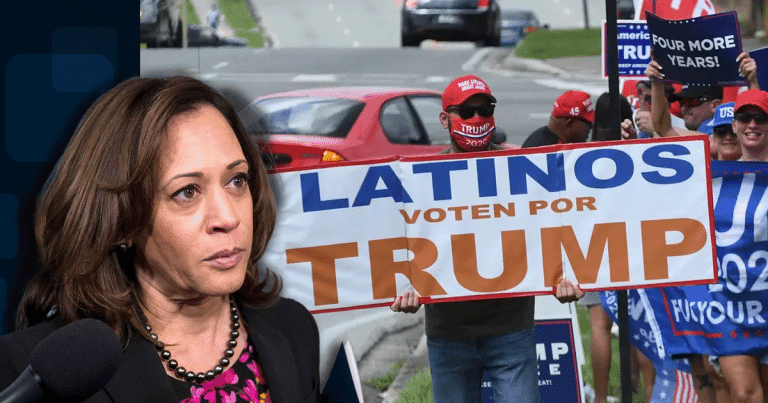
In a move that has left political pundits scratching their heads, Donald Trump has been breaking the rules of traditional Republican campaigning. Instead of focusing only on the Republican base, he has consistently turned his attention toward Democratic voters, particularly minority groups.
Historically loyal to the Democratic Party, these voters are now being courted by a man whose approach to politics has always been unconventional. The result? A reshaping of the American political landscape, with some surprising shifts in voter alignment.
Trump has never shied away from controversy, and his outreach to groups like Hispanic, Black, and Jewish voters has been no different. Many predicted his abrasive style and polarizing rhetoric would alienate these communities.
Instead, Trump has found an unexpected reception, as economic concerns and frustrations with the Biden-Harris administration open the door to a wider audience. His ability to make inroads with traditionally Democratic voters, particularly minorities, is turning heads—and potentially turning the tide for 2024.
From Just the News:
Vice President Kamala Harris is struggling to maintain support among the key voting blocs of the Democratic coalition as polling data suggests that former President Donald Trump’s efforts to win over minority voters are succeeding to some degree…Now, polling data suggests that he may be poised to gain significant ground in the November contest with both groups, as well as the traditionally Democratic Jewish voters.
Kamala Harris in Hot Water
Kamala Harris is feeling the heat. As Trump’s reach into minority communities deepens, Harris, who was once hailed as the face of the Democratic Party’s diverse coalition, is seeing her numbers slip.
Recent polling reveals a worrying trend for the Democrats: minority voters, once their most reliable bloc, are drifting toward Trump. Latino, Black, and Jewish voters are being swayed by Trump’s economic pitches and promises, and Harris’s support among these groups is faltering.
Take Hispanic voters, for example. Traditionally a solid Democratic voting bloc, they’re beginning to warm to Trump. In key battleground states like Arizona, recent polls show Trump gaining traction, with one survey giving him 40% of the Latino vote. Harris still leads at 54%, but Trump’s numbers represent a notable eight-point increase from 2020.
The trend isn’t limited to one poll either—multiple surveys suggest Trump’s momentum is real. If these numbers hold, the once-solid Democratic grip on the Hispanic vote may no longer be a given.
“Cutting the Margin”
John McLaughlin, a pollster with an eye for trends, sees something significant happening. According to McLaughlin, Trump has cut the margin between him and Harris in key states, particularly with Latino voters. In Arizona, for instance, the gap among Latino voters has shrunk by double digits since 2020.
McLaughlin notes that Trump’s message resonates because these voters aren’t as committed to the Democratic Party as they once were. And this isn’t just a localized phenomenon—it’s happening across several battleground states.
For Trump, this marks a remarkable shift. Hispanic voters have been the golden goose Republicans have long chased but rarely caught. While the GOP floundered in the 2022 midterms, Trump is showing signs of flipping the script ahead of 2024. Could this be the year Republicans finally break through with this key demographic?
Jewish Voters and the Israel Factor
Jewish voters, often overlooked in discussions of minority groups, are another demographic where Trump is gaining ground. Traditionally Democratic, Jewish voters are now reconsidering their options in the face of the Biden administration’s handling of the Israel-Hamas conflict.
Pro-Palestinian protests on college campuses and perceived wavering support from Democratic leaders have left many Jewish voters uneasy. Trump, ever the opportunist, has pounced on this vulnerability.
At a recent event focused on combating anti-Semitism, Trump promised a “bright new day” for Jewish Americans, pledging to protect them from discrimination on college campuses and reaffirming his strong stance on Israel. The message appears to be working. In deep-blue New York, a Siena poll found Trump and Harris neck-and-neck among Jewish voters—a group Biden led comfortably just months earlier.
The Black Voter Conundrum
Then, there’s the question of Black voters. Trump’s relationship with Black Americans has always been contentious, yet recent data suggest he is making some gains. A poll in Texas found Trump with 17% of the Black vote—a notable jump from the 6% he earned in 2020.
While this number is far from majority support, it signals a significant shift, especially given that the GOP generally struggles with this demographic.
Trump’s pitch to Black voters centers on economic dissatisfaction. Rising inflation and general frustration with the current administration have opened the door for Trump to make his case. While criminal justice reform was a focal point of his 2020 outreach, this time around, Trump is betting that pocketbook issues will win the day.
Shaking Up the Game
In a political world where candidates often play it safe, Trump is once again rewriting the rules. His outreach to minority voters, particularly those historically loyal to Democrats, could have seismic effects in 2024.
Whether these efforts will pay off remains to be seen, but one thing is certain: Trump is no longer content to play the game by the old rules. As the election approaches, it’s clear he’s not just campaigning—he’s shaking up the entire electoral landscape.
Key Takeaways:
- Trump is reaching out to traditionally Democratic groups like Hispanic, Black, and Jewish voters.
- Polls show Harris losing ground, with Trump making gains among key minority groups, especially in battleground states.
- Trump is reshaping the political scene, gaining more Hispanic, Jewish, and even Black voter support, defying conventional expectations for 2024.
Source: Just the News